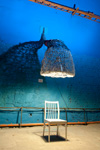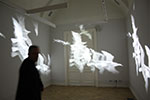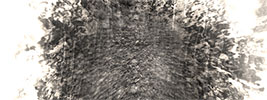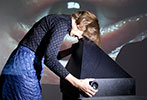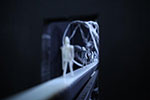Art group ABC, Russia
Synapse, 2011
Sculpture - lamp. Metal carcass. wire, IKEA lamp, mixed technique
Realisation: Natasha Struchkova. Consultant: Maxim Ilyukhin
synapse is a place of contact of two neurons conducting a nervous impulse
This is a lamp, difficult to produce, difficult to manufacture and cumbersome. This is not Philip Stark with his idea of simplicity, where design is a bonus. This is not IKEA with its simplicity and low price for the mass consumer. This is Synapse with its possibility to switch into a network, whether a cognitive, an electric or an exhibitional. The network of contemporary art. Synapse does not aspire for mass production, but being an object of art adds to the conceptual paradigm, works as an idea. A material model of thinking about how we think. It is a unique special object. Light inside the synapse is information.
OnVarious wires are ornately intertwined upon the metal carcass of the object. The theoretical model of synapse has a "bulb", a club-like thickening, called axolema. A lamp is built into the object in that place. The brightness of the lamp can be adjusted by a special handle, adapting to the surrounding light as needed. The size of the thickening is comparable to the size of a person who can stand under the "synapse" and read a book.
bio
 Art group Art Business Consulting was created in 2001 by Maxim Ilyukhin, Mikhail Kosolapov and Natalya Struchkova. The future participants of the ABC met in 1999-2000 at the New Art Strategies courses. Starting from 2002 the group takes part in most important Russian art fairs and festivals: Art Moscow, Art Klyazma, Cultural Capital of the Volga Region, Digital Russia, 1 and 2nd moscow biennial of contemporary arts. In its works the group explores the contemporary business culture, its behaviour and visual stereotypes, interdependence between modern technology and contemporary aesthetics. The works by the artists of ABC group are in the collection of the Tretyakov Gallery, MMOMA, Russian and foriegn private collections.
Art group Art Business Consulting was created in 2001 by Maxim Ilyukhin, Mikhail Kosolapov and Natalya Struchkova. The future participants of the ABC met in 1999-2000 at the New Art Strategies courses. Starting from 2002 the group takes part in most important Russian art fairs and festivals: Art Moscow, Art Klyazma, Cultural Capital of the Volga Region, Digital Russia, 1 and 2nd moscow biennial of contemporary arts. In its works the group explores the contemporary business culture, its behaviour and visual stereotypes, interdependence between modern technology and contemporary aesthetics. The works by the artists of ABC group are in the collection of the Tretyakov Gallery, MMOMA, Russian and foriegn private collections.
Yuri Ancarani, Italy
PIATTAFORMA LUNA, 2011
single-channel installation, video, 25 min



“Piattaforma Luna” tells a story of life and dream chasing after one another and constantly merging together, creating dialogic superimpositions and contrasts. The movie is like a science fiction, a tale that stems from the real emotional journey and from the real life experience of six scuba diving technicians who work in deep ocean water. For several weeks the technicians carry on an off-shore operation aboard the platform Luna, with life shifting in between 100 meters depth under the sea and life in the hyperbaric chamber. This extreme environment does not allow for things to be as they are outside of water. Everything and every action must be reinvented in oder to seem normal. As in his previous movie, Ancarani features common men as protagonists, not heroes, people performing a job, albeit a heavy duty, dangerous one that eventually become just like real heroes. The movie allows the filmmaker to uplift daily life and the invisible realities such as the one presented into something more sublime and visible.
“Piattaforma Luna” is the second in a series of works centering around the theme of labor. The trades that Ancarani accounts for are not very well known professions and they do not often get talked about. However, his movies employ peculiar artistic languages, aesthetics, narrative and compositional ones that are rather different from those used by TV and media in their attempts to transform common people into heroes. “Piattaforma Luna” is a collaboration between and within the system of contemporary art departing from the traditions of the movie industry, independent of its connections.
“Piattaforma Luna” is the first movie being produced by world renowned artist Maurizio Cattelan. International distribution for the movie has been curated by the gallery Zero.
bio
 Yuri Ancarani is an Italian video artist and film maker. His works come from a continuous mingling of documentary cinema and contemporary art, and are the result of a research aimed to explore regions which are not very visibile in the daily life, realities in which the artist delves in first person. Selected festivals: Venice Film Festival (Italy), IFFR (Rotterdam), IDFA (Amsterdam), Hot Docs (Toronto,Canada), Cinéma du Réel (Centre Pompidou, Paris), SXSW (Houston, Texas), Full Frame Documentary Festival (USA), Ann Arbor Film Festival (USA), True/False Film Festival (Missouri). Selected awards: nomination for “Nonfiction feature filmaking”, Cinema Eye Honors (New York); “Grand Prix in Lab Competition”, Clermont-Ferrand Film Festival (France); “Honorable Mention”, Dokufest (Kosovo); “Best documentary”, New Horizon I.F.F. (Poland); “Best Short”, L' Alternativa- Barcelona Independent Film Festival (Spain).
Yuri Ancarani is an Italian video artist and film maker. His works come from a continuous mingling of documentary cinema and contemporary art, and are the result of a research aimed to explore regions which are not very visibile in the daily life, realities in which the artist delves in first person. Selected festivals: Venice Film Festival (Italy), IFFR (Rotterdam), IDFA (Amsterdam), Hot Docs (Toronto,Canada), Cinéma du Réel (Centre Pompidou, Paris), SXSW (Houston, Texas), Full Frame Documentary Festival (USA), Ann Arbor Film Festival (USA), True/False Film Festival (Missouri). Selected awards: nomination for “Nonfiction feature filmaking”, Cinema Eye Honors (New York); “Grand Prix in Lab Competition”, Clermont-Ferrand Film Festival (France); “Honorable Mention”, Dokufest (Kosovo); “Best documentary”, New Horizon I.F.F. (Poland); “Best Short”, L' Alternativa- Barcelona Independent Film Festival (Spain).
Dmitry Bulatov, Alexey Chebykin, Russia
That, which Lives Inside Me, 2011-2012
Installation, snails Achatina fulica
Programming: Konstantin Semenov. Electromechanic engineer: Nikifor Martyshevsky. The project is realized with the financial aid of the Foundation of non-commercial programs “Dynasty”.
That which Lives Inside Me is an installation using the technologies of amended reality, which help to dynamically combine the real and the virtual spaces. Realizing the metaphor of “house-shell”, carried on oitself by a snail, the giant shells of African Achatina fulica snails were “amended” by a kind of “electronic aura” - interactive layer of digital visual information. This information is projected to the screen in real time and is dependant upon the behaviour of the snails - the dynamics of their movement inside the terrarium and intensity of their communication with each other.
For the creation of the estrangement effect the ability of snails for active movement was used. Additional broadcasting of “electronic auras” with 9 hours delay, thus separating “auras” from the “real bodies” by a substantial period of time. In this visual experiment not only the possibilities of amended reality to combine real and virtual spaces in real time are demonstrated. but also the borders of application of these technologies are shown, liberating the viewer’s perception from the mechanical rhythm of interactivity imposed on us by the surrounding life.
bio
 Dmitry Bulatov is an artist and art theorist, curator of the NCCA, Baltic branch, leading expert of the Innovation Park of the I.Kant BFU. He has organised exhibitional and editorial projects in the field of science art and new media. His works were presented at international shows including the 49th and the 50th Venetian Biennial (2001, 2003), Ars Electronica festival (ORF, 2002) etc. He has given lectures in Russia, USA, Canada, Germany, the Netherlands, Mexico, Singapore and Hong Kong. In 2007 he was included in Top 10 authors of most interesting organisms of the year according to the Wired magazine (USA). He is a member of the editorial council of the DOC(K)S magazine for contemporary art (France). He won a national Innovation prize in the field of contemporary art (Russia)
Dmitry Bulatov is an artist and art theorist, curator of the NCCA, Baltic branch, leading expert of the Innovation Park of the I.Kant BFU. He has organised exhibitional and editorial projects in the field of science art and new media. His works were presented at international shows including the 49th and the 50th Venetian Biennial (2001, 2003), Ars Electronica festival (ORF, 2002) etc. He has given lectures in Russia, USA, Canada, Germany, the Netherlands, Mexico, Singapore and Hong Kong. In 2007 he was included in Top 10 authors of most interesting organisms of the year according to the Wired magazine (USA). He is a member of the editorial council of the DOC(K)S magazine for contemporary art (France). He won a national Innovation prize in the field of contemporary art (Russia)
 Alexey Chebykin is an artist and an architect, working in different fields of contemporary art (sculpture, interactive installations), paying attention to the connections between art and modern technology. He took part in Russian and international exhibitions, including Artist and Weapon (Nizhny Tagil, Moscow, Gdansk, 2002-2005), 9000 km (2006), Eastern neighbours (Utrecht, Kalmar, 2006), The Heart of Venice (Italy, 2007), PRAGUEBIENNALE 3 (Prague, 2007), 52th Venetian biennial (GINNUNGAGAP/Pavilion of Belief, 2007), Artissima (Turin, 2007), Schengen (BerlinБерлин, 2008), The Russian Roulette (Wiesbaden, 2008); Monsters - People, Murders, Power Machines (Dresden, 2008), Russian Utopias (Moscow, 2010), Life.Scientific Version (Moscow, 2011). Lives and works in Kaliningrad (Russia).
Alexey Chebykin is an artist and an architect, working in different fields of contemporary art (sculpture, interactive installations), paying attention to the connections between art and modern technology. He took part in Russian and international exhibitions, including Artist and Weapon (Nizhny Tagil, Moscow, Gdansk, 2002-2005), 9000 km (2006), Eastern neighbours (Utrecht, Kalmar, 2006), The Heart of Venice (Italy, 2007), PRAGUEBIENNALE 3 (Prague, 2007), 52th Venetian biennial (GINNUNGAGAP/Pavilion of Belief, 2007), Artissima (Turin, 2007), Schengen (BerlinБерлин, 2008), The Russian Roulette (Wiesbaden, 2008); Monsters - People, Murders, Power Machines (Dresden, 2008), Russian Utopias (Moscow, 2010), Life.Scientific Version (Moscow, 2011). Lives and works in Kaliningrad (Russia).
Elena Gubanova, Ivan Govorkov
Filtration of white nose, 2011
Interactive video installation
programming - Alexey Grachev, Sergey Komarov
video editor - Victor Ryukhin
With support of medialabatory «CYLANDMediaArtLab»
In this video installation, the image is interactively connected to the spectator’s movements. The artists use the video not as a complete art image, but as an art medium.
As a spectator walks into a room, he finds himself inside the video projection that is filling three opposing walls. The picture of white noise flickering non-stop is brought together by three linked projections. The steady buzz of the space “relic radiation” can be heard from the speakers. The spectator feels as if he were being enveiled by the vibrating sphere of black and white.
In the centre of the room there is a mini-stepper (a kind of exercise equipment). That’s a metaphor of a ladder, of ascension. The spectator is supposed to start walking on the mini-stepper and by doing that he gets into the installation which symbolizes the beginning of his life journey.
While making an effort, the walking spectator becomes involved into creation of the image in the centre of the room. The person “startles” the quietness and emptiness of the room by filling it with motion. He “brings to life” the reality and the reflection of the reality and turns “nothing” into “something”.
bio

 Elena Gubanova and Ivan Govorkov work together since 1990. After graduation from the Repin Academy in Saint-Peterburg, they work with different media - painting, sculpture, photography, video art, objects and installations. They had won the Sergey Kuryokhin Prize in the field of contemporary art for “the best work of visual art”. Their works are in state and private collections.
Elena Gubanova and Ivan Govorkov work together since 1990. After graduation from the Repin Academy in Saint-Peterburg, they work with different media - painting, sculpture, photography, video art, objects and installations. They had won the Sergey Kuryokhin Prize in the field of contemporary art for “the best work of visual art”. Their works are in state and private collections.
Boris Debackere, Belgium
Probe, 2008
Interactive installation, generative audiovisual software, color, no language
Sound & image design: Boris Debackere
Software design: VVVV, Sebastian Gregor
Sensor application: V2_ Lab
Probe is an Auguste Orts Production and is produced with the support of the Flanders Audiovisual Fund Probe — noun, an unmanned exploratory spacecraft designed to transmit information about its environment.
Cinema is a virtual capsule with a projection screen as a window, which gives access to an audiovisual trip through time and space. As soon as the film starts the projection surface becomes invisible. It becomes the magic window of the cinema capsule that engages the whole body through the eyes and ears, and abducts you to another time and space. The film machine transforms reality by generating mental activity in the viewer: cinema as a dream machine for condensed experiences and emotions.
Probe is an interactive installation in which the relationship between the viewer and the screen is central. The position of the viewer determines the creation of generative sound and image that physically take the viewer on an audiovisual trip.
bio
 As a media artist his main interest is the possible in- tegration of different expression forms, with an emphasis on electronic sound and image. Most recent work and research is concentrated on translating and transforming the cinema concept into other forms like Live Cinema performances and audiovisual installations. The research project ‘The Cinematic Experience’ (2007), lectures and publication edited with
As a media artist his main interest is the possible in- tegration of different expression forms, with an emphasis on electronic sound and image. Most recent work and research is concentrated on translating and transforming the cinema concept into other forms like Live Cinema performances and audiovisual installations. The research project ‘The Cinematic Experience’ (2007), lectures and publication edited with
Arie Altena. Sound design for Marnix de Nijs’ installations 'Run Motherfucker Run' (2004), 'Beijing Accelerator' (2006) and 'Exploded Views' (2008). Sound design for Herman Asselberghs’ films 'a.m./p.m.' (2004), 'Proof of Life' (2005), 'Capsular' (2006), 'Futur Antérieur' (2007) and 'Altogether' (2008).
Alexandra Dementieva, Belgium/Russia
Nanoscope :: 2111, 2011
interactive video installation / object
Man had always attempted to explain everything that occurred to and around him. In the beginning he did it trough religion and myths. Later, the scientific method of acquiring knowledge became prevalent – scientists advance hypotheses, which then are checked experimentally, and finally a theory is created, and used in practice. Occasionally the links of this process chain trade places.
New technologies are inseparably bound with the development of science which has become one of the biggest hopes for human progress and also one of the most serious threats. This situation has to do with the immense power of scientific technology. Object nanoscope::2111 is a prototype of the future equipment allowing for the limitless magnifying of an observed object. The object of magnifying in this case is a human eye. Nanoscop allows penetration into the depths of its constituent elementary particles, beyond which a spiral infinity opens up. It unifies everything into a tremendous picture of the planetary development, iincluding the rise of a man as a bearer of Reason, which highly accelerated all the processes on the earth.
bio
 Alexandra Dementieva’s main interests focus on social psychology and perception and their application in multimedia interactive installations. Her videowork integrates different elements including behavioral psychology, developing narrative using a 'subjective camera'.
Alexandra Dementieva’s main interests focus on social psychology and perception and their application in multimedia interactive installations. Her videowork integrates different elements including behavioral psychology, developing narrative using a 'subjective camera'.
Her interactive installation projects attempt to widen the mind's potential for perception using different production materials: computers, video projections, soundtracks, slides, photography, etc. Alexandra Dementyeva has received the main prize for the best multichannel video at the international festival of video and digital art VAD, Spain, and a special mention by the jury at the Moscow MIFF Media Forum in 2008. She took part in many exhibitions in the most important Russian and foreign cultural institutions, including the State Hermitage, MMOMA, FILE festival in Sao Paulo, Centro de la Imagen in Mexico and so on. Alexandra Dementieva lives and works in Brussels, Belgium.
Dmitry Kawarga, Russia
Down with Wrestlers with Systems and Mental Nonadapters! 2011
Installation. PC, run-simulator, conveyer belts, metal, plastic, audio device, subwoofer, microphone, micro video camera, monitor, wood cube.
The work created in collaboration with the robotic studio by Moscow Polytechnic Museum
One needs to go on a run-simulator to start up «a social mechanism». On the one hand - one feels himself as the God and on the other hand he is only figure among the others.
The consciousness of visitors is bisecting - is the society absorbs each of us? Or we ourselves form this enslaving mechanism?
If one tells in a microphone the manifesto "DaDa", the voice transfers a low-frequency impulse to the cellular structure, which begins vibration. As a result some of figures fall off, liberated from the structure.
One conveyor has a microvideocamera. It shows on a monitor a space inside a black box – in this box is another reality, the world of the artist.
bio
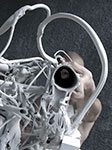 Has a profile art education. Has started to be exposed since 1988. One of few Russian artists working with high technologies. The most considerable works at last several years are based on science-art synthesis and created with scientists and engineers. The winner of art projects competition into the international PRO&CONTRA symposium in 2011, the winner in the nomination "Hybrid Media" of the Lexsus Hybrid Art grant, owner of the honorary mentions in the nominations Interactive Art of the festival Ars Electronica. Kawarga's works are in the Museum of Contemporary Art ART4.RU (Moscow), in the Ecological Museum of local history (Muravlenko), in the Krasnoyarsk's museum centre (Krasnoyarsk), in the Museum Erarta (Saint Petersburg), and also in private collections in Russia and in Europe. Was born in Moscow, lives and works in Moscow area.
Has a profile art education. Has started to be exposed since 1988. One of few Russian artists working with high technologies. The most considerable works at last several years are based on science-art synthesis and created with scientists and engineers. The winner of art projects competition into the international PRO&CONTRA symposium in 2011, the winner in the nomination "Hybrid Media" of the Lexsus Hybrid Art grant, owner of the honorary mentions in the nominations Interactive Art of the festival Ars Electronica. Kawarga's works are in the Museum of Contemporary Art ART4.RU (Moscow), in the Ecological Museum of local history (Muravlenko), in the Krasnoyarsk's museum centre (Krasnoyarsk), in the Museum Erarta (Saint Petersburg), and also in private collections in Russia and in Europe. Was born in Moscow, lives and works in Moscow area.
Sergey Katran, Russia
Big Time Wheel (BTW 16), 2013
Object
Sergey Katran’s installation is dedicated to the deliberation of time. The wheel is a part of the project “The Fabriwue of the Leisure Time”, in which the artist analyses the hidden processes of time and its connection with space.
A mecahnism invented by the artist creates Leisure Time (LT), which in this context is a term, explaining a newly created consistence, appearing as a result of conversion of electric energy into the energy of time (according to N. Kozyrev)
Excessive or Leisure time partially remains on the subjects and objects, staying in close proximity with the BTW16, and partially goes into the atmosphere and dissolves in it into minimal values approaching zero. Human body is a unique device, able to condense huge amounts of the energy of Time. To achieve this, a person should approach the centre of the wheel and stay there until she is filled with the Leisure Time.
bio
 Sergey Katran graduated from the Krivoy Rog state pedagogical institute, faculty of natural science, speciality biology and chemistry. Katran is an artist and inventor, creating art object, installations usually complex, with the help of the newest hybrid media. He practices audio andvideo art and sculpture. Member of the Creative Union of Artists of Russia, section of the newest trends, since 2010. He is an active member of the art group DaDaNet (2011). He received the Lomonosov Art Prize in 2012 for the intellectual achievements in the contemporary art (MSU Philosophical faculty, 2012). Nominated for the Kuryokhin Prize for the best work of visual art in 2013. Took part in many exhibitions in the State Russian Museum, State Tretyakov Gallery, Cultural Foundation Ekaterina, NCCA etc.
Sergey Katran graduated from the Krivoy Rog state pedagogical institute, faculty of natural science, speciality biology and chemistry. Katran is an artist and inventor, creating art object, installations usually complex, with the help of the newest hybrid media. He practices audio andvideo art and sculpture. Member of the Creative Union of Artists of Russia, section of the newest trends, since 2010. He is an active member of the art group DaDaNet (2011). He received the Lomonosov Art Prize in 2012 for the intellectual achievements in the contemporary art (MSU Philosophical faculty, 2012). Nominated for the Kuryokhin Prize for the best work of visual art in 2013. Took part in many exhibitions in the State Russian Museum, State Tretyakov Gallery, Cultural Foundation Ekaterina, NCCA etc.
Where the dogs run, Russia
Installation “Faces of Smell”, 2012
Gas analyzer sensors, printed circuit boards, reinforced plastic and polyethylene tubes, fan, microcontrollers, nettop computer, flat-screen plasma TV, table, rack, wires. 280х180х80 cm
Most people cannot reconstruct smells from memory (it’s rather hard to mentally “picture” a familiar smell, although someone’s face would be pretty easy to visualize). When we try to recall the smell of mint, we end up recalling how mint looks. We can only recognize a smell when experiencing it again. As yet, there exists no mechanism to even approximately reconstruct and reproduce a smell from memory.
However, there is a well-established and widely used method of recalling and recreating a visual image: the facial composite, where a previously seen face is reconstructed by comparing and selecting individual facial features. Artists have decided to use the same method for fixing smells. To do that, they have created an array of gas analyzer sensors that continuously examine the space and the people within their operating range. The data from the gas analyzers constitute a pattern that is unique to this place, this person, and this moment in time – because airflow constantly changes the air composition in the space that is being examined. This unique, ever-changing pattern is visualized in a facial composite. This is how it works: when a person approaches the analyzer, sniffing tubes “sniff” him, then gas analyzers process the information, which then passes to a computer program that translate air composition data into data concerning the shape and position of facial features (the components of a facial composite). As a result, a person sees a face of their smell that is conditional, in no way related to their actual physical appearance. If the same person were to approach the “nose” once again, their portrait would be slightly different (because smell changes constantly), albeit still recognizable. This mechanism is yet another “memory crutch”, obviously deficient and ridiculous, and yet exactly in line with the requirements of total visualization that surrounds us today.
bio

The creative group Where the Dogs Run is a collective of artists and designers, created in Ekaterinburg in 2000. The group works at the juncture of art and contemporary technology, creating cinetic sculptures, objects, installations, photographs, wall paintings, video and performances. The group took part in many exhibitions and festivals, including Stop! Who's coming? (Moscow, 2002, 2003), Kansk video festival (2003), Novosibirsk video festival (2003), On the Resort (Baden-Baden, Germany, 2004), International festival of independent artists (Slovenia, 2005), Moscow biennial 2005, 2007, 2009, Itch (Moscow Tretyakov Gellery, 2005), The Young Aggressive (Tokuo, Japan, 2008
Vladimir Potapov, Russia
Transparent relations, 2012
oil painting/plexiglass, 100 x 100 cm
In the series “Transparent relations” the artist continues his research of new plastic and painting techniques - imitation of screen printing, the use of clear Plexiglas as the basis of image, layering - all these techniques allow for the creation of a 3D image of everyday reality.
“Vladimir Potapov connects the problem of the limits of painting not only with the movement but also with the experience of the body. To become aware of oneself and of one’s look at the world in movement, motility must be correlated with the tactile abilities and visual impressions of the body. In this experience of synthesis a geometrical illusion comes back not as an aesthetic evil downgraded by modernism, but as the situation of the birth of art. Movement imposed on a viewer by Vladimir Potapov, allows us to become aware of painting as a defect of transparency. In this sence it opens us reality as a defect of illusion.”
Alexandr Evangely
bio
 Graduated from the Serebryakov Art Institute, workshop of the artist B.Makhov, Institute for contemporary art, MMOMA Free Workshops. He is the winner of the Russian Art Week festival in 2009, international contest for the best realistic painting and the best surrealistic painting, for professionalism in the Moscow House of Artist. 2nd prize, contest Riot of Colours by the Foundation of Konstantin Smirnov and Vladimir Sorokin, 2013, finalist of the international Jacob Christian Jacobson “Portretnow” contest.
Graduated from the Serebryakov Art Institute, workshop of the artist B.Makhov, Institute for contemporary art, MMOMA Free Workshops. He is the winner of the Russian Art Week festival in 2009, international contest for the best realistic painting and the best surrealistic painting, for professionalism in the Moscow House of Artist. 2nd prize, contest Riot of Colours by the Foundation of Konstantin Smirnov and Vladimir Sorokin, 2013, finalist of the international Jacob Christian Jacobson “Portretnow” contest.




